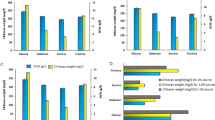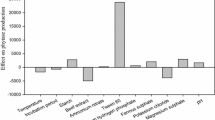Abstract
Cultivation of chitosanase production by Aspergillus sp. QD-2 under submerged fermentation was optimized. Factors including (NH4)2SO4, inoculum size and initial pH were identified by two-level Plackett-Burman design (PBD) as significant for chitosanase production. The path of steepest ascent was undertaken to determine the optimal region of three significant factors. To determine the optimal values of the significant variables, Box-Behnken design (BBD) and response surface analysis were employed. The quadratic regression model of producing chitosanase showed that the optimal cultivation conditions ((NH4)2SO4 5.164 g/l, inoculum size 8.204% (v/v) and initial pH 4.074) resulted in the improvement of chitosanase activity (85.816 U/ml) as compared to the initial level (26.515 U/ml) after 72 h of fermentation. The optimal pH and temperature of the crude chitosanase were determined to be 5.6 and 55°C, respectively.







Similar content being viewed by others
References
Chen X, Xia W, Yu X (2005) Purification and characterization of two types of chitosanase from Aspergillus sp. CJ22-326. Food Res Int 38:315–322
Chiang CL, Chang CT, Sung HY (2003) Purification and properties of chitosanase from a mutant of Bacillus subtilis IMR-NK1. Enzyme Microb Technol 32:260–267
Choi YJ, Kim EJ, Piao Z, Yun YC, Shin YC (2004) Purification and characterization of chitosanase from Bacillus sp. Strain KCTC 0377BP and its application for the production of chitosan oligosaccharides. Appl Environ Microbiol 70:4522–4531
Eom TK, Lee KM (2003) Characteristics of Chitosanases from Aspergillus fumigatus KB-1. Arch Pharm Res 26:1036–1041
Fink D, Boucher I, Denis F, Brezinski R (1991) Cloning and expression in Streptomyces lividans of a chitosanase encoding gene from the actinomycete Kitasatosporia N174 isolated from soil. Biotechnol Lett 13:845–850
Gao XA, Ju WT, Jung WJ, Park RD (2008) Purification and characterization of chitosanase from Bacillus cereus D-11. Carbohydr Polym 72:513–520
Harish Prashanth KV, Tharanathan RN (2007) Chitin/chitosan: Modifications and their unlimited application potential-an overview. Trends Food Sci Technol 18:117–131
Isogawa D, Fukuda T, Kuroda K, Kusaoke H, Kimoto H, Suye SI, Ueda M (2009) Demonstration of catalytic proton acceptor of chitosanase from Paenibacillus fukuinensis by comprehensive analysis of mutant library. Appl Microbiol Biotechnol 85:95–104
Kim K, Ji HS (2001) Effect of chitin sources on production of chitinase and chitosanase by Streptomyces griseus HUT 6037. Biotechnol Bioprocess Eng 6:18–24
Kim SK, Rajapakse N (2005) Enzymatic production and biological activities of chitosan oligosaccharides (COS): A review. Carbohydr Polym 62:357–368
Kim SY, Shon DH, Lee KH (1998) Purification and characteristics of two types of chitosanases form Aspergillus fumigatus KH-94. J Microbiol Biotechnol 8:568–574
Li X, Ouyang J, Xu Y, Chen M, Song X, Yong Q, Yu S (2009) Optimization of culture conditions for production of yeast biomass using bamboo wastewater by response surface methodology. Bioresour Technol 100:3613–3617
Miller GL (1959) Use of dinitrosalicylic acid reagent for determination of reducing sugars. Anal Chem 31:426–428
Moon JS, Kim HK, Koo HC, Joo YS, Nam HM, Park YH, Kang JI (2007) The antibacterial and immunostimulative effect of chitosanoligosaccharides against infection by Staphylococcus aureus isolated from bovine mastitis. Appl Microbiol Biotechnol 75:989–998
Roberts GAF (1992) Chitin Chemistry. Macmillan, Basingstoke, UK
Shimosaka M, Kumehara M, Zhang XY, Nogawa M, Okazaki M (1996) Cloning and characterization of a chitosanase gene from the plant pathogenic fungus Fusarium solani. J Ferment Bioeng 82:426–431
Soni R, Nazir A, Chadha BS (2010) Optimization of cellulase production by a versatile Aspergillus fumigatus fresenius strain (AMA) capable of efficient deinking and enzymatic hydrolysis of Solka floc and bagasse. Ind Crop Prod 31:277–283
Struszczyk K, Szczęsna-Antczak M, Walczak M, Pomianowska E, Antczak T (2009) Isolation and purification of Mucor circinelloides intracellular chitosanolytic enzymes. Carbohydr Polym 78:16–24
Su C, Zhou W, Fan Y, Wang L, Zhao S, Yu Z (2006) Mutation breeding of chitosanase-producing strain Bacillus sp. S65 by low-energy ion implantation. J Ind Microbiol Biotech 33:1037–1042
Sun Y, Han B, Liu W, Zhang J, Gao X (2007) Substrate induction and statistical optimization for the production of chitosanase from Microbacterium sp. OU01. Bioresour Technol 98:1548–1553
Wang J, Zhou W, Yuan H, Wang Y (2008a) Characterization of a novel fungal chitosanase Csn2 from Gongronella sp. JG. Carbohydr Res 343:2583–2588
Wang SL, Chen SJ, Wang CL (2008b) Purification and characterization of chitinases and chitosanases from a new species strain Pseudomonas sp. TKU015 using shrimp shells as a substrate. Carbohydr Res 343:1171–1179
Wang SL, Lin HT, Liang TW, Chen YJ, Yen YH, Guo SP (2008c) Reclamation of chitinous materials by bromelain for the preparation of antitumor and antifungal materials. Bioresour Technol 99:4386–4393
Wang SL, Peng JH, Liang TW, Liu KC (2008d) Purification and characterization of a chitosanase from Serratia marcescens TKU011. Carbohydr Res 343:1316–1323
Wang SL, Chen TR, Liang TW, Wu PC (2009) Conversion and degradation of shellfish wastes by Bacillus cereus TKU018 fermentation for the production of chitosanases and bioactive materials. Biochem Eng J 48:111–117
Wang SL, Chang TJ, Liang TW (2010) Conversion and degradation of shellfish wastes by Serratia sp. TKU016 fermentation for the production of enzymes and bioactive materials. Biodegradation 21:321–333
Xu J, Zhao X, Han X, Du Y (2007) Antifungal activity of Oligochitosan against Phytophthora capsici and other plant pathogenic fungi in vitro. Pestic Biochem Physiol 87:220–228
Yang EJ, Kim JG, Kim JY, Kim SC, Lee NH, Hyun CG (2010) Anti-inflammatory effect of chitosan oligosaccharides in RAW 264.7 cells. Cent Eur J Biol 5:95–102
Zaharoff DA, Rogers CJ, Hance KW, Schlom J, Greiner JW (2007) Chitosan solution enhances both humoral and cell-mediated immune responses to subcutaneous vaccination. Vaccine 25:2085–2094
Zeng J, Zheng LY (2002) Studies on Penicillium sp. ZDZ1 chitosanase immobilized on chitin by cross-linking reaction. Process Biochem 38:531–535
Zhang J, Sun Y (2007) Molecular cloning, expression and characterization of a chitosanase from Microbacterium sp. Biotechnol Lett 29:1221–1225
Zhang XY, Dai AL, Zhang XK, Kuroiwa K, Kodaira R, Shimosaka M, Okazaki M (2000) Purification and characterization of chitosanase and exo-β-D-glucosaminidase from a koji mold, Aspergillus oryzae IAM2660. Biosci Biotechnol Biochem 64:1896–1902
Zhu XF, Wu XY, Dai Y (2003) Fermentation conditions and properties of a chitosanase from Acinetobacter sp. C-17. Biosci Biotechnol Bioch 67:284–290
Zhu XF, Zhou Y, Feng JL (2007) Analysis of both chitinase and chitosanase produced by Sphingomonas sp. CJ-5. J Zhejiang Univ Sci B 8:831–838
Acknowledgement
This research was supported by the encouragement foundation of Department of Science & Technology of Shandong Province of China for excellent middle-aged scientists (NO.2005gg3202084).
Author information
Authors and Affiliations
Corresponding author
Electronic supplementary material
Below is the link to the electronic supplementary material.
Rights and permissions
About this article
Cite this article
Zhang, H., Sang, Q. & Zhang, W. Statistical optimization of chitosanase production by Aspergillus sp. QD-2 in submerged fermentation. Ann Microbiol 62, 193–201 (2012). https://doi.org/10.1007/s13213-011-0246-1
Received:
Accepted:
Published:
Issue Date:
DOI: https://doi.org/10.1007/s13213-011-0246-1




